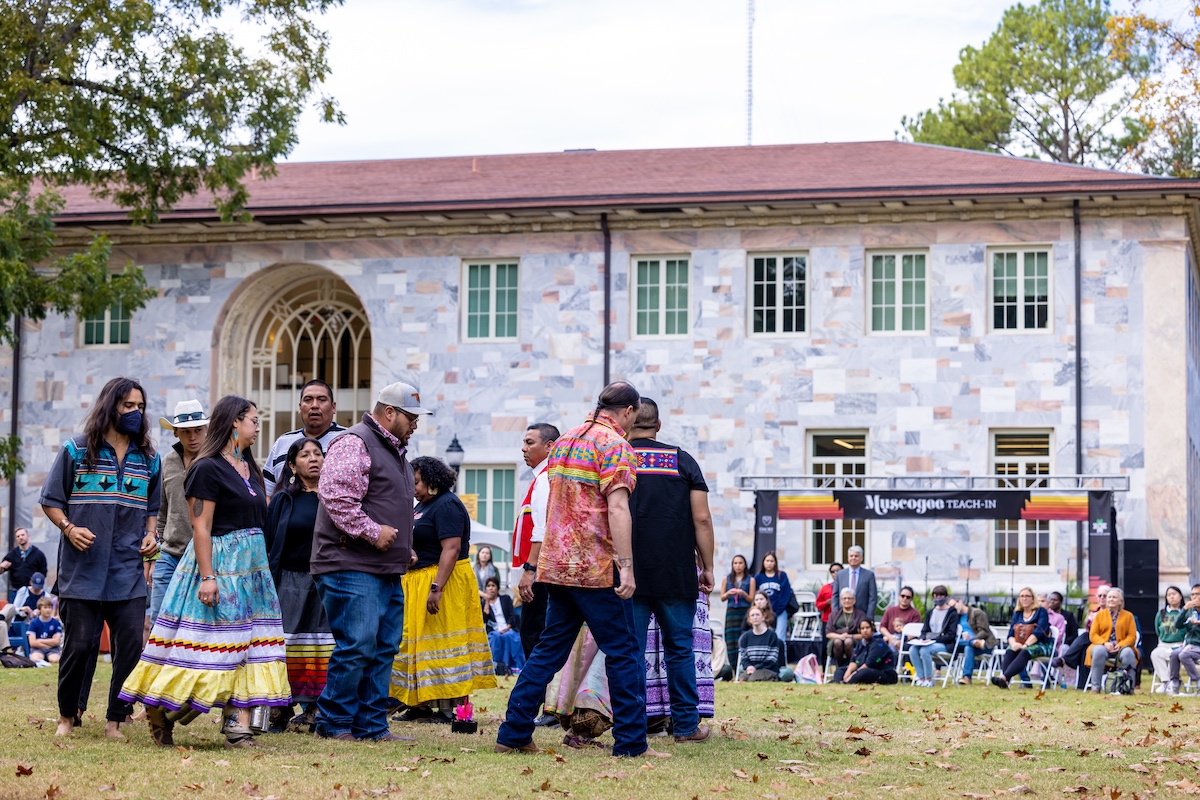There is so much yet to learn from the members of the Muscogee Nation.
And the fruits of the relationship between the Muscogee Nation and Emory are being expressed in a number of meaningful ways, including a second teach-in that will take place on the Atlanta campus Oct. 27.
Last fall, the first teach-in delighted a crowd of about 200 who had gathered on the Quad. This year’s event will be held in the Emory Student Center.
Programming will include:
- Opening remarks from Barbara Krauthamer, dean of Emory College of Arts and Sciences; Carol Henderson, vice provost for diversity and inclusion; and student Tre’ Harp III 25C (Muscogee/Choctaw)
- Hymn singing
- Storytelling led by Mvhayv (or “teacher”) Jordan Squire and Mvhayv Carolyn McNac, along with Elizabeth Rowland, language revitalization project manager, from the Mvskoke Language Program
- A conversation with Muscogee artist Johnnie Diacon
- A stomp dance led by Rev. and Mekko (or “traditional leader”) Chebon Kernell
Activities will get underway in the student center’s Multipurpose Rooms at 2:30 and run until 5:30 p.m. Light refreshments will be served. Registration is required.
The teach-in is sponsored by Native American and Indigenous Studies, Office of the Provost, Emory College of Arts and Sciences, James Weldon Johnson Institute and Office of Spiritual and Religious Life.
Using art to heal: The work of Johnnie Diacon
During his visit to Emory, artist Johnnie Diacon will discuss depicting Muscogee culture in his pieces — why he shares these images and considers it important to educate the public about the world they invoke. Diacon will select several pieces from his portfolio and highlight the creative process behind them.
Among Diacon’s most well-known pieces is the “Trail of Tears” mural, completed in 2021, for the Museum of Native American History in Bentonville, Arkansas. Each individual depicted has a blanket of a different color or pattern representing the different personal family stories that each person who made the journey carries with them.
About the mural, Diacon says: “It’s a memorial when we do these pieces. It’s our ancestors, our relatives, and it’s an honor and a tribute to them.”
Diacon began entering Native American art competitions as a self-taught artist. “I never won a prize, but I never took anything home; my art sold,” he recalls. Eventually, seeking formal training, Diacon mastered what is known as the Traditional, Flat or Bacone School style of Native American painting. He went on to study at the famed Institute of American Indian Arts in Santa Fe, New Mexico.
Following the death of two of his children, Diacon took a 14-year break from art. But in 2014, while observing the eagles of Grey Snow Eagle House, an eagle-rehabilitation program, he received what he believed to be a sacred message from them: “No matter how bad one has been hurt, we are still what the Creator has made us and with faith and the help of many, we continue to do as He wishes using the gifts that He has bestowed on each of us.”
A deepening relationship with the College of the Muscogee Nation
This marks the third year that members of the College of the Muscogee Nation (CMN) have visited Emory; in addition to last year’s teach-in, in 2021 they were involved in presentations or as speakers for the “In the Wake of Slavery and Dispossession” symposium.
In February 2023, the Andrew W. Mellon Foundation awarded Emory and the CMN in Oklahoma a $2.4 million grant to develop collaborative and independent programs advancing Native and Indigenous Studies and the preservation of the Muscogee language in a unique partnership between the two schools.
A new Center for Native American and Indigenous Studies, launched at the start of the semester, will put into action the goals associated with the Mellon grant. The center already has welcomed Emory College’s first Distinguished Fellow in Indigenous Knowledge, Laura Harjo, a Muscogee scholar and an associate professor at the University of Oklahoma who teaches Indigenous planning, community development and Indigenous feminism.
Malinda Maynor Lowery, Cahoon Family Professor of American History and a member of the Lumbee Tribe of North Carolina, is leading the center with support from Emory’s James Weldon Johnson Institute.
Lowery also is part of the planning for the teach-in, about which she says: “The partnership and sense of exchange — trust building and shared learning — is growing between Emory and the Muscogee Nation. The teach-in adds a dimension of responsibility and relationship that builds on Emory’s Land Acknowledgment Statement.”
The teach-in will not only edify; it will heal. “We are in need of the healing that this return of the Muscogee people to their homelands facilitates,” Lowery says. “The Nation is leading us in the way that they use education as a healing force.”

Participants join in a stomp dance on the Quad during last year's teach-in. These traditionally are limited to tribal members, but on this day were generously extended to the entire Emory community.

